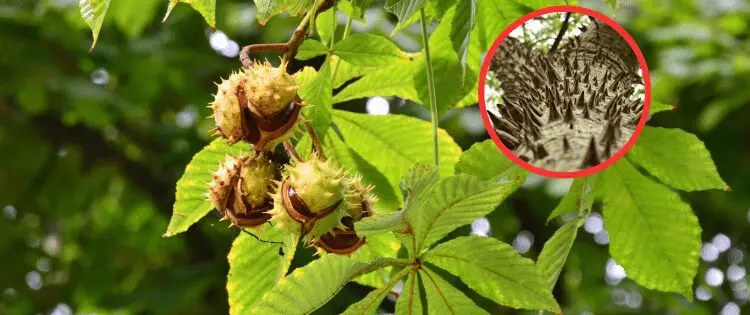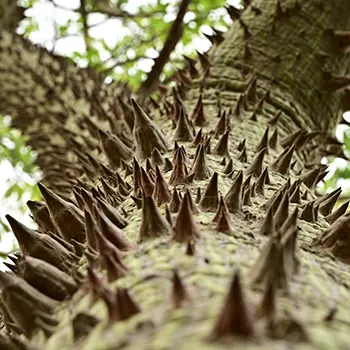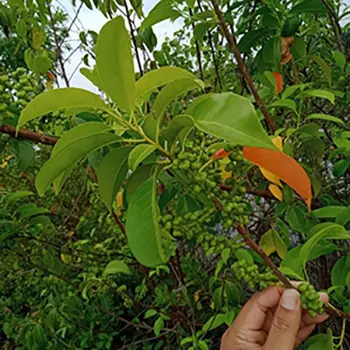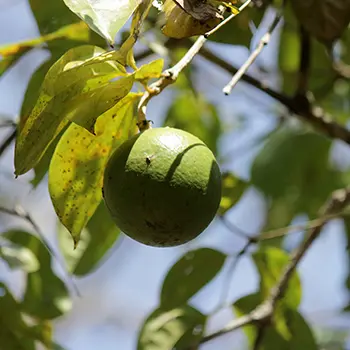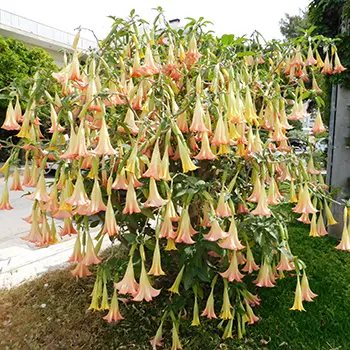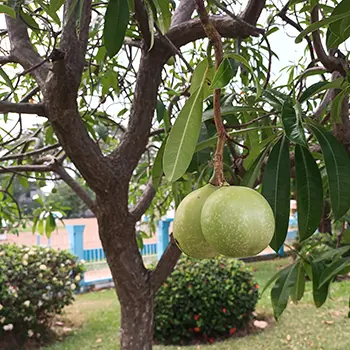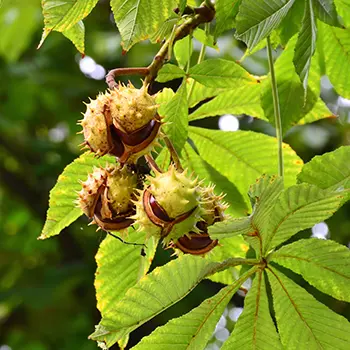Trees are a great addition to any landscaping plan. They provide shade and privacy, attract wildlife and fill your yard with beauty. Trees can even be a quick source of food when needed.
However, while trees are generally a good idea, there are some trees that you do not want to find growing in your backyard.
There are some trees that can be harmful to your health and some that are even toxic. It is essential to understand which trees are safe and which you should avoid at all costs.
Manchineel Tree
The Manchineel Tree, sometimes referred to as the Beach Apple tree, is found throughout southern Florida. Named the world’s deadliest tree by the Guinness Book of World Records, you do not want this beast growing in your backyard.
All parts of the Manchineel Tree are highly toxic, and a brush in with this terrifying foliage can have dire consequences. The fruit of the Manchineel resembles small green apples and is sweet, making them a target for curious children or weary wanders.
Unfortunately, these fruits are extraordinarily toxic, and consumption of these small apples can lead to severe stomach and intestinal issues, blistering and burning of the skin, inflammation, and even death.
Related: The Most Dangerous Tree In The U.S.
The manchineel tree is so toxic, in fact, that they are often cordoned off, and warning signs are posted alerting passers-by of their deadly properties. It is said that taking shelter under a Manchineel Tree during the rain will lead to blistering of the skin and other harsh consequences.
It is best to avoid this tree if possible, and should you find one growing in your yard, call a professional to remove it. Smoke from the burning wood of the Manchineel tree can cause blindness, respiratory issues, and even death in some cases. Every part of this terrifying tree is highly toxic to humans.
Sandbox Tree
The Sandbox Tree is terrifying, and it belongs on any list of the most dangerous trees. Found throughout the Americas, the Sandbox Tree has sharp spikes along its trunk and poisonous sap that can cause a nasty rash.
Worse than its ferocious exterior, however, are the small green fruits that garnish the branches of this frightening tree. What makes these small pumpkin-like fruits so deadly is that they tend to explode without warning. Yes, you read that right.
Once these fruits reach maturation, they can suddenly explode, catapulting their seeds at speeds upwards of 240 km per hour. Anyone in the path of this tree may be in serious trouble if these rogue fruit seeds strike them.
While these trees may sound like something out of your nightmares, they do have their uses. Fishers sometimes use the milky sap of the Sandbox Tree to poison fish. It has also been used to create poisonous arrowheads for battle throughout history. Oil extracted from the tree makes an excellent laxative and is used to treat ailments around the world. The leaves are used to treat eczema, and when correctly handled, the extracts of this tree can treat rheumatism and intestinal worms.
Other names for The Sandbox Tree include Monkey’s dinner bell, monkey’s Pistol, and Possumwood.
Milky Mangrove
The Milky Mangrove usually grows close to bodies of water and may develop as a shrub or a tree. Milky Mangrove trees can reach 15 meters and feature gray or fawn-colored bark and pale green or yellow leaves.
This tree, primarily found in and around Australia, gets its name from the milky sap it produces. This sap is highly toxic, causing severe skin irritation or temporary blindness.
Despite its toxicity, this sap treats various diseases, including chronic ulcerous disorders such as leprosy.
The Mangrove Tree itself is often used to promote pollination for beekeeping, and the wood of the tree is used as incense and in canoe construction. The Mangrove Tree protects shorelines and provides a habitat for many different forms of marine and terrestrial wildlife.
Oleander
Oleander is more of a shrub than a tree, but this beauty packs a punch. The trees flower from early summer until mid-autumn and have large clusters of red, yellow, pink, or white blossoms. With time and patience, an Oleander bush can be trained into a single-trunk tree. However, in its bush form, it provides an excellent source of privacy, making it a popular garden choice.
Although beautiful, Oleander is toxic to both pets and humans.
Thus, you may want to avoid planting this splendor in your garden. Every part of the Oleander tree is poisonous, and ingesting even a tiny amount of this magnificent flowering plant may be deadly. This plant holds two distinct toxins, oleandrin, and neriine, both of which can lead to severe illness or possibly even death.
Related: Dwarf Fruit Trees You Can Grow In A Tiny Space
Symptoms of Oleander poisoning include heart rhythm disturbances which are often accompanied by nausea, vomiting, cramping, and bloody diarrhea. Oleander can also cause confusion, dizziness, weakness, drowsiness, and visual disturbances.
Despite the danger that Oleander presents, the seeds and leaves are used to make medicine. Oleander is used to create drugs for heart conditions, asthma, epilepsy, cancer, painful menstrual periods, leprosy, malaria, ringworm, indigestion, and venereal disease. Oleander is also one of the main ingredients used in medications that cause abortions.
Although Oleander is an attractive addition to any garden, you should heed the warnings or suffer the consequences.
The Strychnine Tree
A medium-sized evergreen tree, the Strychnine tree, commonly found in Southern Asia and Australia, is the primary source of Strychnine – the fatal poison used in the movies to kill cheating husbands.
The tree itself is rather unremarkable, growing to around 36ft. in height. The wood of this tree is white, dense, and durable and has irregular branches covered in smooth, ashen-colored bark. The tree also produces funnel-shaped, foul-smelling flowers that grow in small clusters throughout its branches. The leaves, around 4 inches long and 3 inches wide, are oval-shaped and grow in alternate pairs. Along with pungent flowers, you will find small fleshy berries close.
These berries are orange-red and approximately 4 centimeters in diameter. Strychnine berries are covered in a hard, smooth shell that contains jelly-like pulp inside.
Within each berry are five seeds that are very hard, flat, and round.
Related: The 10 Best Trees For Homesteaders
The distinct seeds of the Strychnine tree are where the deadly poison is contained. However, all parts of this plant are poisonous, from the roots and bark to the leaves, berries, and seeds.
Strychnine is a highly toxic material acting on both the muscular and nervous systems. Exposure to Strychnine can cause tetanic tonic contractions and lead to death. Symptoms of Strychnine poisoning include violent convulsions, high blood pressure, confusion, vertigo, dullness in the head, internal soreness, acute headache, sensitive scalp, pressure in the temple and/or head, pressing pain in the eyes, pressure in the ears coupled with complaints of hissing noise, swelling of the gums, ulcers in the mouth, pain in the teeth, a heavy tongue, and paralysis.
Besides being the go-to poison in Hollywood Blockbusters, Strychnine trees have been processed into cancer treatments.
The dried seeds are used for the treatment of neuro-disorders, arthritis, and vomiting. This plant has different uses as a herbal remedy in Chinese medicine, as reported in the medical literature. The Strychnine tree and its properties are used in formulating more than 60 Indian systems of medicine.
Angel’s Trumpet
Angel’s Trumpet is a bell-shaped flower that is popular in gardens. Considered an annual Shrub, this plant can grow up to 20 feet high. Angel’s Trumpet comes in orange, white, pink, and yellow. This plant blooms in spring, summer, or fall and is known to keep deer at bay.
Although pretty and popular, the Angel’s Trumpet is poisonous and holds poisons such as tropane alkaloids within its folds. These toxins might cause severe hallucinations, often known for putting people into a zombie-like state.
Angel’s Trumpet is a fast-growing plant. With a fair amount of sun, this plant will produce flowers all summer long. Although Angel’s Trumpet is in the shrub family, most varieties form small trees with a central stem.
All parts of the Angel’s Trumpet Plant are poisonous. You must understand the dangers of this beautiful plant and place it with care.
Angel’s Trumpet should not be planted in areas where children play or where pets frequent. Angel’s Trumpet has been banned in several communities because of its highly toxic nature, so be sure to check city ordinances before planting. All parts of the angel’s Trumpet are considered poisonous.
Related: The Best Fruit Trees to Grow in Five Gallon Buckets
The alkaloids atropine, scopolamine, and hyoscyamine contained in this plant can cause serious harm.
If ingested, Angel’s Trumpet can cause disturbing hallucinations, paralysis, tachycardia, and memory loss. Consuming Angel’s Trumpet can be fatal. However, Angel’s Trumpet has been used ritualistically and as herbal medicine by indigenous peoples and their shamans.
Part of the nightshade family of plants, Angel’s Trumpet flowers and leaves are often used to create various medicines. Angel’s Trumpet is sometimes used recreationally to induce hallucinations and instill a feeling of euphoria. However, the use of Angel’s Trumpet is hazardous, and it should never be willingly ingested.
Although dangerous for recreational use, Angel’s Trumpet has been used for centuries in India to treat various ailments.
One of the only remaining uses of Angel’s Trumpet is the treatment of asthma. While some painkillers were available that contained extracts of this plant, they have since been banned due to widespread misuse. Angel’s Trumpet is also known as Jimsonweed, Thorn Apple, or Devil’s Trumpet.
‘The Suicide Tree’
The seeds of ‘The Suicide Tree,’ also known as The Murder Tree or Cerbera Odollam, have reportedly been used in more suicides and murders than any other plant in history. This tree, native to India and other parts of southern Asia, contains a toxin called cerberin. This potent compound disrupts the function of your heart muscles, leading to an irregular heartbeat that can be fatal.
The flavor of this poisonous plant is easily disguised in food, and medical examiners notoriously overlook the toxin. Due to this, some refer to cerberin as the perfect murder weapon. In fact, between 1989 and 1999, Cerbera odollam reportedly caused more than 500 deaths in the Kerala state of India alone.
Symptoms of Cerbera odollam poisoning include a burning sensation in the mouth, vomiting, headache, irregular heartbeat, and respiration. It can even lead to coma and, as noted above, death.
The fruit of the suicide tree is not without its uses. Scientists manufacture bioinsecticides, deodorants, and feedstock for use in the production of biodiesel.
So despite being one of the most poisonous trees, it does have at least some benefits.
Hemlock
Probably one of the most notorious trees on this list, the Hemlock is best known for its use in ancient Greek culture as a means of execution and suicide. Claiming its most famous victim when the philosopher Socrates took his own life in 399 BC., Hemlock has a place in history and lore. However, despite its violent, romanticized past, Hemlock is still quite common and highly toxic to humans.
Found throughout the United States, ingesting even small amounts of any aspect of this plant’s potent toxin will cause ascending muscular paralysis. This paralysis can eventually reach the respiratory muscles and result in death.
The Hemlock plant has white flowers that grow in clusters, and the stem is decorated with purple spots. The Hemlock plant will grow up to 9 ft tall and produce flowers year-round in some locations.
This poisonous tree was first introduced to the U.S. as a garden plant from Europe but is considered a noxious weed in 12 U.S. states, including Oregon and Washington. Purposely planting Hemlock is illegal in many places.
Related: Antidote Plants That Grow Near Poisonous Ones
While all parts of this plant are dangerous, the leaves are particularly toxic. Poisonous Hemlock affects nerve impulse transmission to your muscles, eventually killing you through respiratory failure. Until the leaves produce flowers in the spring, even small amounts of Hemlock leaves can kill a grown man or leave him in bad shape.
Even briefly touching Hemlock can cause severe skin reactions in some people with no known antidote. The biggest problem with Hemlock is that it is often mistaken for parsley or wild parsnips and unknowingly ingested. Hemlock is a primary cause of accidental poisoning.
Symptoms of Hemlock poisoning include burning in the digestive tract, trembling, increased salivation, dilated pupils, muscle pain, weakness or paralysis, rapid heart rate followed by a dramatic decline in heart rate, loss of speech, convulsions, loss of consciousness, or coma. In more severe cases of Hemlock poisoning, you might see central nervous system depression, respiratory failure, acute rhabdomyolysis or a breakdown of damaged skeletal muscle, acute renal failure, and death.
Horse Chestnut
The Horse Chesnut became popular because of its beautiful flowers. This tree thrives in mild climates and provides many benefits, provided you do not consume the raw seeds.
When consumed, raw seeds from a Horse Chesnut can induce nausea, vomiting, extreme thirst, and in some cases, may lead to paralysis and death. Toxic to both humans and animals, the Horse Chesnut is one tree you want to avoid while enjoying nature.
Horse Chesnut Trees have distinctive white flowers, whose branches are pink at the base. The fruit of the Horse Chesnut is encased in an unmistakable green, spikey shell that holds the toxins within.
These trees can grow up to 125 ft high or more, so you can’t miss them, and they should be avoided.
Poison Oak
While this is not a tree but rather a vine or shrub, it is common to find Poison Oak growing up trees along walking trails or in thick brush.
It can be recognized by its distinctive scalloped leaflets grouped in threes on the branches.
It has red along the edges of its leaves and also sprouts small white flowers during the spring.
Poison Oak causes a severe skin reaction in those who touch it, and ill-prepared hikers may find that their ankles are covered in blistering sores if they pass through poison oak on their journey. Poison Oak will cause rashes, burning, blistering, and swelling ranging from mild to severe depending on exposure.
Related: You Should Never Plant This Near Your House
The oil of the Poison Oak can also get on clothing or pets’ fur and be transferred that way, often making it challenging to discover the source of poisoning.
Rashes and blistering from Poison Oak are very painful and can last for long periods. The aftereffects of poison oak can cause scarring in more severe cases. Due to its commonality, it is best to understand and know how to identify this plant if you plan to explore nature.
Enjoy time outdoors, but do so with caution. If you plan to hike, it is best to wear clothes that cover your arms and legs and avoid touching any plants or trees you do not recognize. Researching where you plan to hike can also help you avoid a painful or even deadly encounter with any of the trees I have listed here.
This article first appeared on Ask A Prepper.
You may also like:
The One Tree That Every Homesteader Should Plant
How to Make Bark Bread from a Tree that Grows on Almost Every Street in America (Video)

